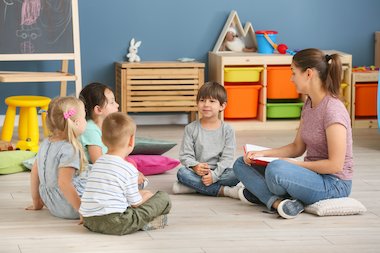EYFS activities to help children process their emotions during the pandemic
Add to My Folder
In this article, educational expert Hilary White suggests a range of fun activity ideas suitable for Early Years.

While we all are getting to grips with the ‘new normal’ way of living, it is business as usual when it comes to supporting the learning and development of the children in your care. It is, however, worth remembering that stress and anxiety levels are higher than normal for most of us. With this in mind, many of the following activities have a focus on exploring and expressing feelings, encouraging purposeful movement as a means of ‘letting off steam’, spending time outdoors and allowing for free, child-initiated play. If you have enough adults in the setting, there are also some suggestions for one-to-one work – which can be useful if you are caring for children who are new to your setting or showing signs of stress. The activities have been grouped under the EYFS seven areas of learning, and each activity includes an extension that can be adapted for older children and KS1 groups.
As providers of childcare you count as key workers, and the nation owes you a huge debt of gratitude for your hard work and commitment. As you continue to look after and support the learning and development of the children in your care, make sure you also find time to look after your own health and well-being. Encourage colleagues to join in with some of the activities below, and share your discoveries with the children as you face these difficult times together.
Personal, social & emotional development
Take it Easy
What to do
Create a ‘take it easy’ box for children to use whenever they feel in need of taking some time out, calming down or cheering up. Include resources that have a calming and/or cheering effect – cuddly toys, soft fluffy blankets, stress balls (make your own with cornflour and balloons), kaleidoscopes, snow globes, laminated cards with happy scenes, sound and texture board books and so on. Introduce the box and its contents to the children, explain its purpose and place it in a cosy, accessible space. Observe the box in use and remove or add resources based on your observations. Encourage children to come up with their own suggestions for items to add to the box.
Extension
Ask children to draw calming and/or cheerful pictures and write calming word, phrase and challenge cards (‘relax’, ’be happy’, ‘give your friend a smile’). Laminate the pictures and cards, and add them to the ‘take it easy’ box.
Follow the Feeling
What to do
Play a version of Follow my Leader, telling a story as you go and incorporating different movements and feelings. Set out on a walk, preferably outdoors, and begin your story – ‘I was walking round the lawn (everybody walk) when I spotted a beautiful pink rose which made me feel very happy (everybody stop and smile). I skipped across the lawn and tripped (everybody skip, then fall on the ground). It made me feel sad (everybody pretends to cry) ...’ and so on. Adjust the story, the feelings you act out and the group size to suit the age and concentration levels of the children. If you are working with new children or children who struggle to focus, work one-to-one or keep the group to just two or three. The activity can be carried out spontaneously and last for as long or short a time as you wish.
Extension
Let children work in twos or threes and make up their own stories, taking it in turns to be the leader. Talk through different feelings with them, write a list on the white board for them to refer to, and encourage them to include a variety of feelings in their story.
Feelings Flower Vases
What to do
Give each child a ready-cut card flower shape to decorate with paint, and attach stalks to the flowers using strong parcel tape (green canes for supporting plants make good stalks). Stick a photo of each child’s face to the centre of the flower and ask them to write their names on labels to stick beneath their faces. Set up a small number of sturdy flower vases and make cards showing different facial expressions (sad, happy, worried, angry). Discuss with the children how they are feeling, and help them choose which vase to put their flower face into. Use the activity on an ongoing basis with individuals or small groups, to encourage them to think about and communicate their feelings. Help them to understand that we are allowed to feel sad, worried or angry as well as happy and cheerful. Keep repeating the message that there is always somebody in the setting who can help us with our difficult feelings.
Published 22 April 2020
Reviews
You need to be signed in to place a review.